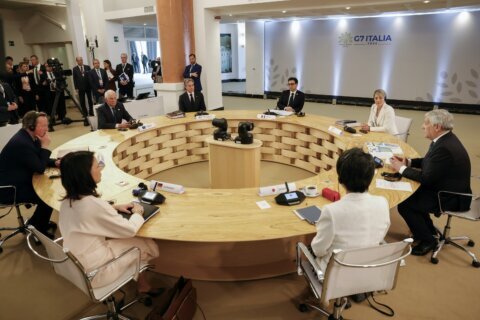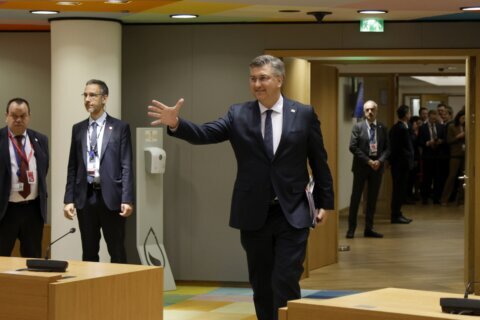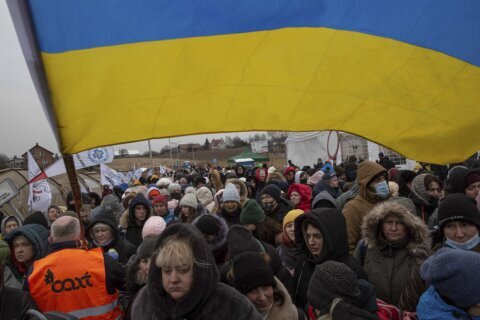A roundup of some of the most popular but completely untrue stories and visuals of the week. None of these are legit, even though they were shared widely on social media. The Associated Press checked them out. Here are the facts:
___
Posts spread fictional tale of ‘Ukrainian beauty’ who blew up 52 tanks
CLAIM: Photo of woman in a military uniform shows “Ukrainian beauty” who “blew up 52 invading Russian tanks.”
THE FACTS: The woman in the photo is a military doctor, not a combat soldier, according to news reports, posts on her Facebook account and messages from her mother. A misrepresented photo of a trauma doctor in Ukraine is the latest example of false propaganda and disinformation that have overwhelmed social media in response to Russia’s war on Ukraine over the past seven weeks. The widely-shared photo showed a young woman in a camouflage jacket decorated with medals and pins, including one with a Ukrainian flag. Twitter posts touted her as a combat hero, responsible for destroying Russian military vehicles. “This Ukrainian beauty blew up 52 invading Russian tanks,” read one tweet that was shared more than 9,000 times. “Retweet if you think she’s a HERO,” another Twitter user added. But the information is incorrect. A reverse-image search found the photo of the Ukrainian woman, Maj. Victoria Palamarchuk, appeared in an article about her work as a military doctor. The article was published in March 2021 by ArmyInform, an information agency of the Ukrainian Ministry of Defense. The article described Palamarchuk as a traumatologist who began working for the Ukrainian military in 2014. ArmyInform said in 2021 that she was a senior resident of the traumatology department who operated on patients with gunshot wounds, performed amputations and carried out other surgeries at a military medical clinic in the eastern Ukrainian city of Dnipro. The Associated Press used Facebook to locate Palamarchuk’s mother, Tatyana Palamarchuk, who confirmed the claims she blew up 52 tanks were false. “About tanks – it’s a fake! Victoria is a military doctor, trauma surgeon,” the elder Palamarchuk wrote in a Facebook message in Ukrainian. “She does not need false merits. She has something to be proud of and rightly so.” Tatyana Palamarchuk said her daughter was too busy with work to respond to the false claim, but shared her daughter’s Facebook account, which corroborated her residence in Dnipro and her work as a trauma doctor. When Palamarchuk learned about the false claims spreading about her, she reported them to Ukraine’s state security service, the SBU, her mother said. A wider internet search found Palamarchuk was featured in other media reports, including various interviews published on YouTube and a feature story on her participation in a military motorcycle club.
— Associated Press writers Ali Swenson in New York contributed this report with additional reporting from Arijeta Lajka in New York.
___
Private gift shop, not White House, selling coins honoring Zelenskyy
CLAIM: The Biden administration “dedicated two commemorative coins” to Ukrainian President Volodymyr Zelenskyy.
THE FACTS: The White House Gift Shop, which is a private company and not part of the federal government, is selling the coins. The White House-themed shop recently began selling two coins focused on Zelenskyy — one honoring him, the other commemorating his address to Congress. But social media posts in recent days have wrongly claimed that it was the White House itself behind the coins. “The US Presidential Administration dedicated two commemorative coins in the ‘Historical Moments’ series to Ukraine and its President Volodymyr Zelenskyy,” reads one tweet, which included a screenshot of the coins from the White House Gift Shop. But that shop, despite its name, is not operated by the federal government. It’s a private company. While the store was associated with the White House when it was founded in the 1940s as a “flower fund” for the families of White House police officers, that is no longer the case. “The White House Gift Shop is privatized,” Anthony Giannini, CEO and executive director of the shop, told the AP. Giannini said he officially acquired the shop in 2012 from the now-defunct U.S. Secret Service Uniformed Division Benefit Fund. U.S. Patent and Trademark Office records show that “White House Gift Shop” is trademarked by Giannini Strategic Enterprises, a Pennsylvania company. The shop used to operate in Washington, D.C., but no longer has a physical location. It operates online and has a distribution center in Rochester, Michigan, near Detroit, Giannini said. Separately, the nonprofit White House Historical Association operates two retail shops, including one at the White House Visitor Center.
— Associated Press writer Angelo Fichera in Philadelphia contributed this report.
___
Fake BBC tweet spreads fabricated Macron quote
CLAIM: The BBC tweeted that French President Emmanuel Macron said France needs to be prepared to take up to 60 million refugees from Africa and the Middle East over the next 20 years because sanctions against Russia will cause economic collapse in Africa.
THE FACTS: The BBC never tweeted this, and Macron has not argued that France, a country of 67 million people, needs to prepare for 60 million refugees. As French citizens prepare to vote in the April 24 runoff election that will decide the country’s next president, social media users are sharing an image made to look like a BBC tweet to push a false narrative about the incumbent candidate. “France’s President Macron tells re-election audience, ‘Europe needs to be prepared to take up to 60 million refugees, over the next 20 years, from Africa and the Middle East,’ as he warns that sanctions on Russia are leading to economic collapse in Africa, which imports vast amounts of Russian wheat,” the fake tweet read. It was manipulated to look like a screenshot of a post from the account @BBCWorld on April 11. The doctored image included a photograph of Macron with BBC News branding in the bottom left corner. But the tweet was not posted on any BBC account, nor does it reflect any real story published by the broadcaster, the BBC press office confirmed to the AP in an email. “This isn’t a BBC article and we encourage audiences to visit the BBC News website if they’re unsure if a story is real,” the BBC press office wrote. The office also reposted an April 17 tweet from BBC journalist Shayan Sardarizadeh pointing out the misinformation. The Internet Archive saved a snapshot of the @BBCWorld Twitter profile less than five hours after the tweet was allegedly posted and showed no evidence of the post. The text in the fake tweet also was too long for Twitter, exceeding the platform’s 240-character limit. The quote attributed to Macron in the tweet is not real, Macron’s office confirmed to the AP. While France is a major destination for asylum-seekers, Macron’s centrist government expels thousands of migrants every year who don’t qualify for asylum and has toughened immigration policy. His rival in Sunday’s presidential runoff election, nationalist Marine Le Pen, would sharply curtail immigration if elected, and her supporters have sought to paint Macron as soft on the issue.
— Ali Swenson in New York contributed this report with additional reporting from Associated Press writer Angela Charlton in Paris.
___
Cloud seeding hasn’t caused flooding in Australia
CLAIM: A rain-enhancing process known as cloud seeding caused historic flooding in Tasmania, Australia, in 2016 and along Australia’s southeastern coast this year.
THE FACTS: There’s no evidence to suggest that cloud seeding played a role in either flood, and an atmospheric research expert told the AP that cloud seeding would not change the dynamics of a cloud enough to cause massive flooding. In recent months, Australia’s southeastern coast has experienced some of its worst flooding in more than a decade, leading some social media users to highlight a previous instance of flooding and spread false theories about what caused it and other floods over the years. Twitter users are sharing a clip from a 2016 news broadcast about flooding in Tasmania to claim it proves that cloud seeding — which involves spraying fine particles of silver iodide and dry ice into a cloud system to enhance precipitation — provoked the heavy rainfall. In the 2016 clip from the Australian TV network 7News, a journalist says, “Residents in southern Tasmania are demanding to know why cloud seeding was conducted over the Derwent River catchment the day before the worst floods in 40 years.” One social media user shared the old clip Tuesday with a caption claiming that cloud seeding made flooding worse. But a probe by the Tasmanian government into the 2016 flooding has since been completed, and investigators found that cloud seeding by Hydro Tasmania, a government-owned generator of renewable energy, did not contribute to or worsen the heavy rains. “Hydro Tasmania (HT)’s cloud seeding activities on 5 June had no impact on precipitation, with this conclusion having a solid scientific basis,” stated the June 2017 independent report. Hydro Tasmania also denied that its flights were to blame and said in a statement that “the operation had no measurable impact on rainfall on that day.” A Hydro Tasmania spokesperson told the AP that it has since stopped cloud seeding. Sarah Tessendorf, a project scientist at the Colorado-based National Center for Atmospheric Research, said cloud seeding “does not have the ability to suddenly produce all kinds of heavy rain and snow.” She said the process would not dramatically worsen clouds that are already forecast to produce severe weather, either. Everything from wind speed, air movement and updraft, or a current of rising air, can affect a storm’s strength, Tessendorf added. A really strong storm, she explained, will already have a very strong updraft and wind flow characteristics that help create the cloud to begin with. “We’re not altering the updraft of the clouds. We don’t have that technology,” she said. “This type of microphysical response is very unlikely to produce such an overwhelming change in the cloud.” Social media users are also sharing a separate example to baselessly claim that cloud seeding played a role in deadly flooding that happened throughout February and March in Queensland and New South Wales. One widely shared post singled out the aviation company Handel Aviation to make the unfounded claim that it ran a cloud seeding flight that was contributing to large-scale flooding in Lismore. Handel Aviation posted a statement in response calling the claims “misinformation” and denying that it conducts cloud seeding flights, stating that it only operates an aerial photography aircraft. That aircraft was capturing images of the flood damage at the time, according to the statement. Nearmap, which analyzes and distributes the company’s photos, confirmed in a statement to the AP that the claims associating Handel’s recent flight with cloud seeding are false. The aerial images were commissioned after the flooding and were used to document the impact on property and infrastructure, according to the statement. Archives of Handel Aviation’s website dating back to 2008 show that cloud seeding services have never been mentioned or offered.
— Associated Press writer Sophia Tulp in Atlanta contributed this report.
___
Find AP Fact Checks here: https://apnews.com/APFactCheck
___
Follow @APFactCheck on Twitter: https://twitter.com/APFactCheck
Copyright © 2024 The Associated Press. All rights reserved. This material may not be published, broadcast, written or redistributed.







